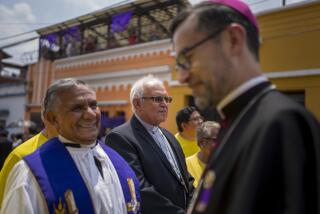Sanctuary: Its Architects and Antagonists : THE AMERICAN SANCTUARY MOVEMENT<i> by Robert Tomsho (Texas Monthly Press: $18.95; 256 pp.) </i>
- Share via
In 1981, the U.S. sanctuary movement began as a few men and women responding to the needs of Central Americans fleeing death and violence in their native countries. It has grown into a nationally based network of more than 300 congregations, city councils and other organizations pledging safe haven and support to those refugees whose presence in the United States is considered illegal by federal authorities.
Robert Tomsho has chronicled the beginnings of this movement in a generally readable manner. He weaves together the necessary background of the movement with the stories and lives of those involved in the early days of sanctuary. The 1986 trial and conviction of eight sanctuary workers on charges of conspiracy and alien smuggling closes the narrative and also focuses the movement’s challenge to our society’s view of the realities of Central America.
To his credit, Tomsho places the growing sanctuary network in the political realities that made it a necessity. The history of the movement is framed by chapters on El Salvador and Guatemala, the homelands of most Central Americans fleeing to the United States. Testimonies of those who have fled the violence give credence to continuing reports of human-rights abuses in Central America as well as the author’s own analysis of current conditions there.
The role of the U.S. government also receives keen attention. The reluctance to grant political asylum to refugees from El Salvador and Guatemala (INS and the Reagan Administration consider them economic immigrants) and the role of the United States in the wars of Central America are highlighted. Some of Tomsho’s best writing is found in these sections.
The power of this part of the book underscores its one weakness: Those working against the sanctuary movement seem more committed in their work, and ultimately, seem to be more interesting people than those working for it. This happens because Tomsho says almost nothing of the beliefs that ground the sanctuary movement.
Sanctuary is essentially a commitment of faith, activity derived from biblical values of safe refuge and compassion for all people. While Tomsho’s sympathies are clearly with the sanctuary movement, he neglects to develop adequately the motivation that inspires its members. Liberation theology receives less than a page, and the biblical concept of sanctuary itself is summarized in two paragraphs.
The result is a narrative that revolves around church people and their communities without truly including the sources of their prophetic commitment to those most in need. Whatever else one might think about sanctuary, the fact that its workers are people of conviction is unquestionable. This dimension does not receive significant attention in the book.
Yet even with this reservation, Tomsho is to be credited for a narrative that tells a side of the story far different from the one most people know. As the sanctuary movement continues to grow, his book will become a valuable resource for its history.
More to Read
Sign up for our Book Club newsletter
Get the latest news, events and more from the Los Angeles Times Book Club, and help us get L.A. reading and talking.
You may occasionally receive promotional content from the Los Angeles Times.








